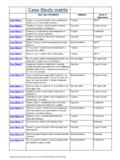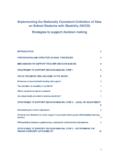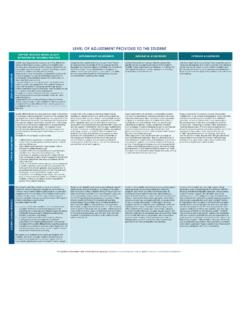Transcription of Nationally Data on School Students with Disability (NCCD ...
1 Nationally Consistent Collection of Data on School Students with Disability ( nccd ) Quick Guide Contents 2 Nationally Consistent Collection of Data on School Students with Disability Page Purpose of the Quick Guide 3 Preparation 4 Role of the principal 5 Background 6 Defining Disability & understanding the Standards 12 Making it happen in your School 16 Requirement of evidence 31 What works? 37 Reflection 39 Case studies 42 Purpose of the Quick Guide What is the purpose of the Quick Guide? Communicate the purpose of the Nationally Consistent Collection of Data on School Students with Disability ( nccd ) from the School s perspective Promote knowledge and understanding of the fundamentals of the nccd , Disability Discrimination Act 1992 (DDA) and Disability Standards for Education 2005 (the Standards) Provide guidance to School teams on the application of the nccd model Provide guidance on the scope of the four levels of adjustment Provide guidance to School teams on using their professional judgement to make decisions including providing reasonable adjustments, determining the category of Disability , identifying evidence and collecting data Highlight key areas of reflection for supporting Students with Disability and completion of the nccd Demonstrate application of the nccd model through case study examples 3 Nationally Consistent Collection of Data on School Students with Disability To return to the table of contents, click here.
2 Preparation Are you prepared? Schools have different levels of experience in regards to the data collection. The following checklist can be used to establish a School s state of preparedness for the data collection. The timeframe for the activities is ideally between January May (Term 1). The checklist should be used in conjunction with the data collection model and resources available on the national website, and the Key activities & Timeframes . 4 Nationally Consistent Collection of Data on School Students with Disability School completed Activity School key contact and leadership team established School principal understands their leadership role in establishing and maintaining effective learning and support processes that respond to specific School context School team ensures that the four elements of personalised learning are understood by all staff School team consolidates understanding of the DDA and requirements under the Standards School staff members have engaged in training on the Standards Key staff members have reviewed National Support Materials, including the reflection tool School commences discussions and establishes processes for the data collection School team establishes processes for consultation with parents as required under the DDA.
3 The Standards and personalised learning School commences identifying Students who are currently receiving adjustments to address a Disability , and the evidence as part of personalised learning to support their inclusion School team has mechanisms in place to ensure ongoing professional dialogue between colleagues to develop and maintain consistency of teacher judgement School team seeks assistance from its state or territory authority or sector representative as needed To return to the table of contents, click here. Role of the principal What is the role of the principal in the data collection process? The School principal is the facilitator of the data collection process ensuring that all staff are aware of the process and their obligations under the DDA and the Standards. This may require making time available for staff to undertake professional learning The principal may identify and nominate a team which will be responsible for driving the data collection process The principal should ensure that all staff are aware of and understand the data collection process The parents/carers of each student to be included in the national data collection should be informed that data relating to the adjustments being provided for their child will be included in the data collection.
4 School principals should verify or confirm that there is evidence at their School to support the inclusion of a student in the data collection 5 Nationally Consistent Collection of Data on School Students with Disability ( nccd ) To return to the table of contents, click here. Background 1 What is the nccd ? The Nationally Consistent Collection of Data ( nccd ) on School Students with Disability collects information about Students with Disability across Australia in a consistent, reliable and systematic way It counts the number of School Students with Disability receiving educational adjustments to allow them to participate in education on the same basis as Students without Disability The national data collection has been progressively implemented over the period 2013-2015. From 2015, all government and non-government schools participate annually in the national data collection. What is the purpose of the nccd ? Build an evidence base that will provide teachers, schools and sectors with information on Students with Disability and the level of educational adjustment being provided To inform policy development and future planning to better equip schools and education authorities/sectors to support Students with Disability Enhance understanding of, and reinforce in schools, the requirements and responsibilities of School teams and the broader community under the DDA and the Standards Capture the work of schools under the obligations of the DDA and the Standards that allows Students with Disability to access and participate in education on the same basis as other Students Provide an enhanced focus on the individual needs of each student by focusing on the level of educational support provided to them in the School context Background 7 Nationally Consistent Collection of Data on School Students with Disability How will the data be used?
5 The data collected by schools will: -Inform better targeting of resources to support Students with Disability -Inform future policy and programme planning in relation to Students with Disability From 2018, the student with Disability loading for Commonwealth funding for schools will be based on the nccd . The document Fairer funding for Students with Disability on the Australian Government Department of Education and Training website ( ) provides more information. Where does the data go? The data goes to the national collection Agency, currently the Australian Government Department of Education and Training In some cases this will involve the School passing the data directly to the department and in other cases the School will provide the data to its state and territory government agency or other relevant body, depending on the School s particular arrangements The information will not identify individual Students Background 8 Nationally Consistent Collection of Data on School Students with Disability What is personalised learning and support?
6 Personalised learning requires attention to the unique needs of Students of all abilities, acknowledging the different learning needs of each student It aims to fulfil the diverse capabilities of each student There are four elements in personalised learning -Consultation and collaboration with the student and/or their parent or carer -Assessing and identifying the needs of the student -Providing reasonable adjustments to address the identified needs of the student -Monitoring and reviewing the impact of adjustments To read more on personalised learning and support, please click here. What is the connection between personalised learning and support and the nccd ? The nccd captures the work of schools in the provision of personalised learning and support for Students with Disability Personalised learning and support and the nccd 9 Nationally Consistent Collection of Data on School Students with Disability 10 Nationally Consistent Collection of Data on School Students with Disability Greater understanding The nccd helps schools gain a greater understanding of their student population and identify areas of need for both Students and staff Recognise support and adjustments provided The nccd helps to formally and consistently recognise the support and adjustments provided to Students with Disability How does the nccd assist schools?
7 Review learning & support systems By capturing the work of schools in the provision of personalised learning and support, the nccd helps schools better understand the level of need within their student population. Develop professional judgement The professional learning available to support the nccd process helps build professional judgement of School teams in making educational adjustments for Students with Disability rather than relying on a medical or clinical diagnosis alone nccd model What is the model for the nccd ? The model for the nccd relies on the professional judgement of teachers about their Students . It requires teachers and schools to make evidence-based decisions about: - Students with Disability who are receiving reasonable adjustments to access education, consistent with the definitions and obligations under the Disability Discrimination Act 1992 (DDA) and Disability Standards for Education 2005 (the Standards) -The level of adjustment being provided for each student with Disability , in both classroom and whole of School contexts -The broad category of Disability the student best falls within that is driving the need for the adjustments provided to the student 11 Nationally Consistent Collection of Data on School Students with Disability To return to the table of contents, click here.
8 Defining Disability & understanding the Standards 2 Which Students are included in the nccd ? A student is counted in the nccd if they meet two criteria: -The student meets the definition of a person with Disability as defined in the DDA -The functional impact of the student s Disability results in the School actively addressing their needs eLearning on the Standards is available here. Practical guides about the Standards prepared by the University of Canberra for parents and the community can be accessed here. What is an imputed Disability ? An imputed Disability is a Disability that someone believes another person has and the School team has reasonable grounds to make such a judgement There does not have to be a formal diagnosis but the School should assess the functional impact of the student s imputed Disability in relation to education The student s parent and/or carer must have been consulted to better understand the student, their needs and identify reasonable adjustments The definition of Disability in the nccd 13 Nationally Consistent Collection of Data on School Students with Disability The national data collection is based on the obligations of all schools under the DDA and the Standards and captures the work of schools in responding to Students in the context of those obligations The definition of Disability in the nccd What is a Disability as defined in the DDA?
9 The DDA defines Disability as: Total or partial loss of the person's bodily or mental functions Total or partial loss of a part of the body The presence in the body of organisms causing disease or illness The presence in the body of organisms capable of causing disease or illness The malfunction, malformation or disfigurement of a part of the person's body A disorder or malfunction that results in the person learning differently from a person without the disorder or malfunction A disorder, illness or disease that affects a person's thought processes, perception of reality, emotions or judgment or that results in disturbed behaviour And includes a Disability that: Presently exists; or Previously existed but no longer exists; or May exist in the future (including because of a genetic predisposition to that Disability ); or Is imputed to a person To avoid doubt, a Disability that is otherwise covered by this definition includes behavior that is a symptom or manifestation of the Disability .
10 To read more on the DDA, please click here. To read the factsheet on the DDA, please click here. 14 Nationally Consistent Collection of Data on School Students with Disability The definition of Disability in the nccd Understanding the Standards The Standards clarify and elaborate the legal obligations of education providers towards Students with Disability under the DDA and set out how education is to be made accessible to Students with Disability The Standards seek to ensure that Students with Disability Can access and participate in education on the same basis as other Students Have opportunities and choices which are comparable with those offered to Students without Disability Are provided reasonable adjustments in consultation with the student and their parents/carers to enable access and participation Schools must adhere to the Standards as part of normal practice consulting with parents and making adjustments The Standards cover enrolment, participation, curriculum development, accreditation and delivery.











